As Aidan Harte’s Púca sculpture gets used to the view in its adopted home in the aptly named townland of Poulaphouca, Co Clare, you could be forgiven for wondering if the people of Ennistymon might now be regretting their missed opportunity. For anyone who hasn’t followed the story: early images of the proposed sculpture provoked an angry reaction among some Ennistymon residents, leading to a report commissioned by Clare County Council, which noted 79 submissions mention the word “ugly” and 11 “hideous”. Realising that someone’s objectionable eyesore is another’s glorious wonder, the councillors went about finding an alternative site.
The Púca might not be quite on the scale of Antony Gormley’s Angel of the North, which put the northern English city of Gateshead on the map back in 1998, but the right piece of public art in the right place can turn a location into a destination, or simply make it a nicer spot to be. The problem is that when it comes to art, not everyone agrees what constitutes the right piece, or even the right place. But how much does location matter? Does a change of site change meaning? And how upset do artists get when their artworks aren’t met with universal acclaim?
Artists creating a public artwork do it with a site in mind. Despite that, we are well used to moving statues in Ireland. Sculptures move with a frequency that would put Ballinspittle’s 1985 Virgin Mary to shame, and it’s not a new practice. While some countries grapple with what to do with historically tricky symbols, others take a different approach. Looking at lichen-covered statues to forgotten men, it’s tempting to think they’re eternal, but in Hungary, you can visit Szoborpark (Memento Park), where statues from the communist period have been relocated. A visit is an intriguing and salutary reminder that the powerful fall, and bronze versions of vainglorious dictators look ludicrous when removed from their plinths.
Back in the day, the topic was largely ignored by the governments of what would become the newly constituted Republic, although others, including the IRA, had their own solutions. In Dublin, King George II, sited in St Stephen’s Green, was blown up in 1937, as were William of Orange on College Green in 1946, Lord Gough in Phoenix Park in 1957 and Nelson’s Pillar on O’Connell Street in 1966. Queen Victoria, who had been placed more safely in the grounds of Leinster House, was put into storage, then shipped to Australia in the 1980s, but her husband Prince Albert remains. He was moved around the corner and is today half-hidden at Leinster House, his status altered from powerful monarch’s consort to awkward embarrassment.
READ MORE
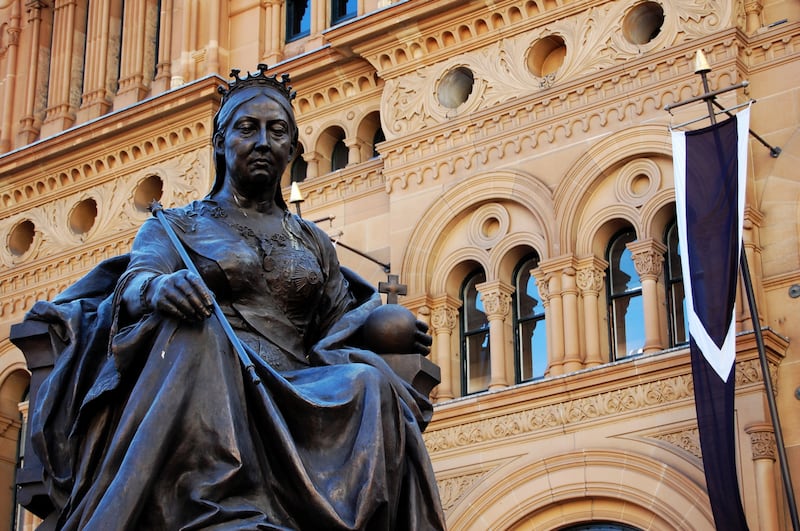
Taking issue with symbols of oppression is one thing, but as the Púca controversy proves, statues also move on aesthetic or social grounds. When Peter Fink installed his Parable Island in the Pimlico area of Dublin’s Liberties in 1988, it had been preceded by consultations with local residents. However, his large red scaffolding-style structure, with its geometric steel shapes and jutting angles, soon became a local climbing frame. Away from the artist’s persuasive presentation of context, it was unloved and ultimately removed.
In Dún Laoghaire, Wexford artist Michael Warren’s Gateway had been erected under the Percent for Art Scheme, by developer Eddie Sweeney, outside the Pavilion complex in 2002. The 6m-high Corten steel sculpture was said to have been inspired by 18th-century Dublin gateways, and photographs show the twin pieces echoing the Victorian arches of the former railway building that currently houses Hartley’s Restaurant.
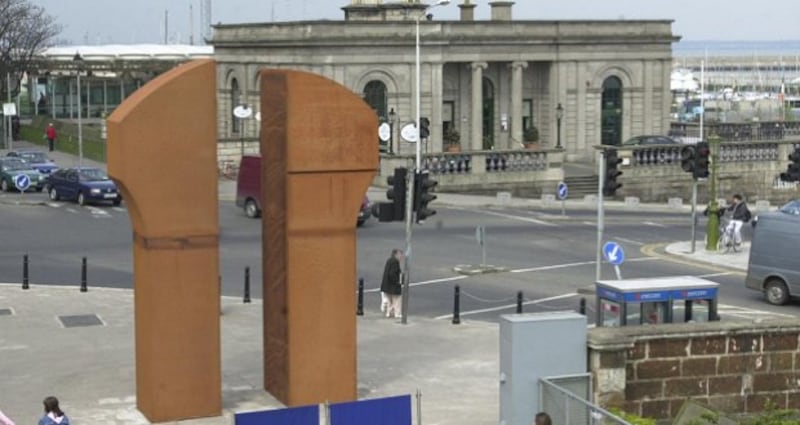
Warren is one of Ireland’s most celebrated sculptors, but Gateway was controversial from the beginning. Quickly a target for graffiti, it was “temporarily” removed during redevelopment works in 2009, and returned to the artist in 2015. The then-councillor Mary Mitchell O’Connor said there “will be few tears shed over its departure”; while councillor Victor Boyhan differed, saying: “I can think of no greater insult to an artist than to reject his site-specific commissioned work, which was previously endorsed by the council.”
It’s worth remembering that while the passage of time might make many of those men on the top of plinths into obsolete strangers, or worse, representatives of now toxic regimes, it can also soften loathing of art that jars because it is initially unexpected and different. When the Eiffel Tower was first proposed, a petition was published in Le Temps, signed by luminaries of the day, bewailing the “gigantic black smokestack” that would soon be “crushing under its barbaric bulk Notre Dame, the Tour Saint-Jacques” and so on. Soon it would become a cherished symbol of the city.
In fairness, at 330m, the Eiffel tower is massive and a bit tricky to simply decommission or move, but smaller pieces of public art survive by consent. Sited at the junction of Buckingham Street and Foley Street, Leo Higgins’s Home (2000) has endured, not least because the sculpture, which marks the lives lost in the area due to the heroin epidemic, was chosen by a committee drawn from the community in a process organised by Firestation Artists Studios. The central bronze flame was cast in the tradition of church bells, with representatives of bereaved families attending the foundry, adding mementoes of their loved ones to the molten metal.
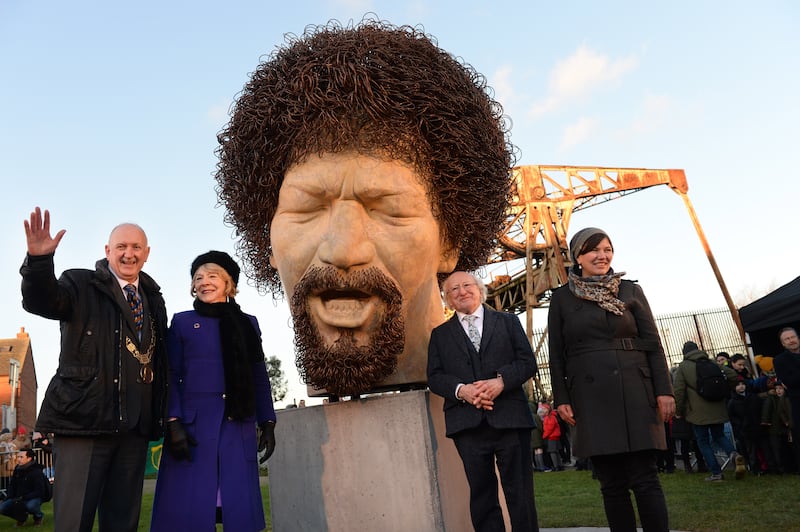
It has fared far better than Vera Klute’s 2019 bust of Dubliners legend, Luke Kelly, which was vandalised seven times in just 18 months. The North Wall Community Association said it was “frustrating” but “not unexpected”, and insisted that the sculpture should be protected rather than moved, a sentiment with which the public art manager with Dublin City Council, Ruairí Ó Cuív, concurs. “This was the community where Luke was born,” he said after the vandalism, adding that “better-off parts of the city have plenty of statues, our ambition in the arts office is to bring culture right throughout the city”.
Whether Éamonn O’Doherty’s 1988 Anna Livia was moved from its site on O’Connell Street because the representation of the river, in which the reclining figure sat, quickly became a target for local kids with bottles of washing-up liquid, or their older brothers and sisters with bottles of a different kind, is undocumented. Suffice to say, the Floozie in the Jacuzzi lasted just 13 years on Dublin’s main thoroughfare, before being packed up in a wooden box and stored in a potting shed in Raheny. Her crime? Not “fitting in with plans for [O’Connell Street’s] regeneration”.
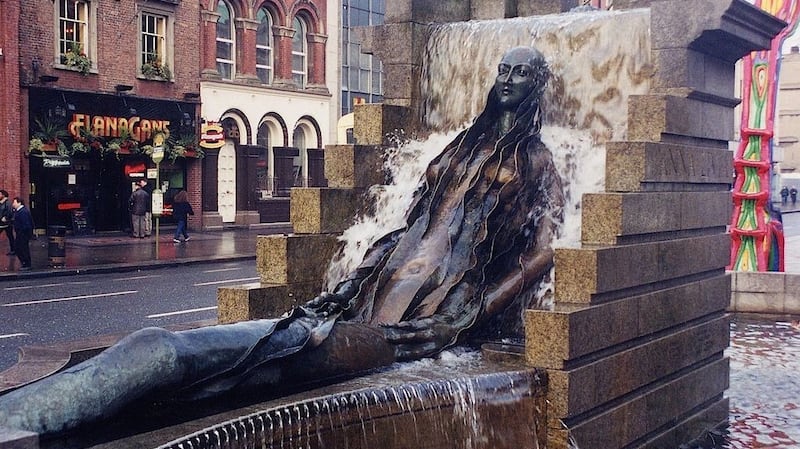
After 10 years in exile, she reappeared, with the artist’s blessing, in a pool at the Croppy Acre Memorial Park near the National Museum at Collins Barracks. At the time, O’Doherty said “it should never have been taken away from O’Connell Street in the first place”, although he did declare himself pleased with the outcome, saying “this little park is a perfect setting for her”. Anything would be preferable to a potting shed.
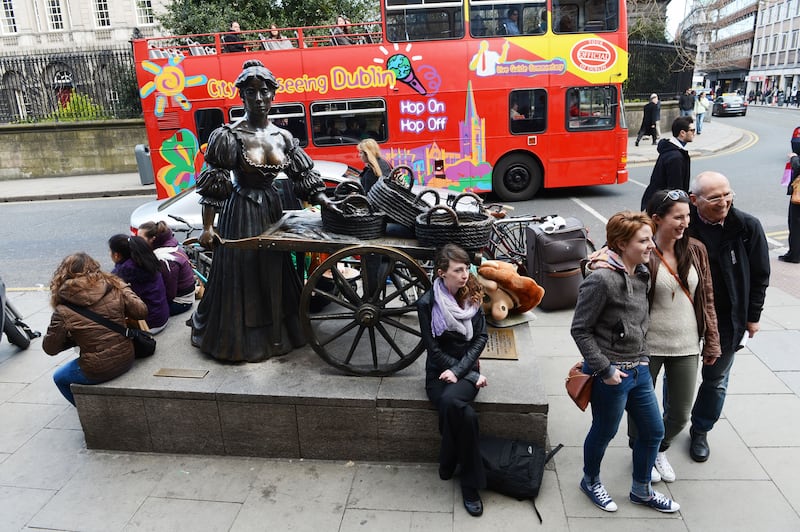
Parable Island and Anna Livia were both commissioned as part of Dublin’s 1988 millennium celebrations, as was Jean Rynhart’s Molly Malone. Molly moved from her spot at the bottom of Grafton Street to facilitate the Luas cross-city works in 2014. Her new spot on Suffolk Street outside St Andrew’s Church turns out to have been fortuitous, as Ó Cuív explains. “One of the myths about Margaret Malone, said by some to have been the real ‘Molly’, is that she was baptised in St Andrew’s Church,” he says.
“The best of public art is rooted in its location, in the context and meaning of site, place and time,” he continues. But does that mean if a statue moves, it loses meaning? It can, but as the case of Molly Malone proves, it can also layer on new ones. Moving an artwork isn’t undertaken lightly, and it is done in consultation with the artists in the case of contemporary works. As Ó Cuív points out, it might change its qualities in terms of context, but “moving an artwork doesn’t lose its aesthetic qualities. Our galleries and museums are full of religious artefacts and paintings taken out of their context, and they’re still fabulous artworks,” he says.
Back to that knotty problem of aesthetics, Don Cronin’s statue of Quiet Man star Maureen O’Hara was removed from Glengariff, O’Hara’s adopted home in west Cork, in May of this year, just 48 hours after its installation. Cronin, who has many beloved public artworks under his belt, including Bull (2007) in Macroom, requested the tribute to O’Hara be removed following a slew of vociferously negative online comments. Cronin is an artist who prefers not to explain his work. “I never understood poetry until I left school,” he said in an interview. “I never appreciated it, because poetry, when you’re studying, is all about explaining it. You pick up none of the magic.”
Online negativity may be the result of just a handful of people with time on their hands and an axe to grind, and isn’t necessarily representative of wider opinion. In 1986, Kinsale’s prize for winning the National Tidy Town contest was a public art commission, sponsored by the Arts Council. Two years later, Eilis O’Connell’s The Great Wall of Kinsale was unveiled, in a ceremony attended by more than a thousand people. Among them were 12 protesters.
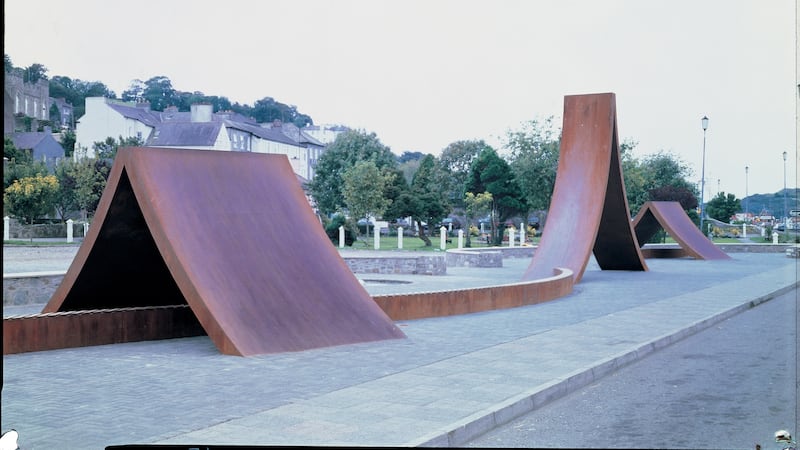
Artist Sean Lynch made a study of the unfolding story in the Cork town for his 2011 exhibition, A Rocky Road, which explored the reception of art in Ireland. According to Lynch, “local councillor Dermot Collins objected on the basis that the piece was not in keeping with the touristic ‘old world’ charm of the town”, and that a group “vociferously continued to lobby against the sculpture’s presence through local petitions, articles and letters in newspapers”. A year later, the Arts Council suggested modifications, designed to meet allegations of the sculpture being a public danger, and today its Corten steel has been painted over, and barriers put in place. These were carried out against the artist’s wishes, and she has declared that the sculpture “was destroyed a long time ago”, adding that under the Berne Convention for the protection of literary and artistic works, “what they did back then in the late 80s would be illegal today”.
The recent Sculpture Dublin project saw the commissioning of permanent and temporary public artworks, including Alan Phelan’s RGB Sconce, Hold Your Nose, for the O’Connell plinth outside City Hall, the plinth having been vacant since the statue of Daniel O’Connell was moved inside the building. The brightly coloured candelabra is full of resonances from, and reflections on its site, and yet Phelan is sanguine about its impending move, following the conclusion of its residency on the plinth this September. “Public sculptures are mutable,” he says. “Everyone puts their own meaning on them. No matter how much context and sub-stories you add as an artist, people will still look and have their own ideas. People are more respectful of the exchange of meanings in a gallery, but that’s the beauty of art. You can say what you like about it.”
Phelan is currently in negotiations for a new location, and he is quick to acknowledge that more risks can be taken with a temporary artwork as opposed to a more traditional form. But while public opinion clearly matters, we also need to give riskier artworks time. Harte said at his Púca’s eventual unveiling: “There is a sound reason why public art is typically not selected by a vote.”
Lynch continued to explore the theme of public art and its reception with his 2015 Adventure Capital exhibition for the Venice Biennale. There, he included a small model of the late John Burke’s modernist sculpture, Uniflow (1988). Commissioned by Cork City Council, it was quickly removed when local residents complained it had become a meeting spot for underage drinkers. They also didn’t like its sharp edges. According to Lynch, “Uniflow was moved to a council depot where it lay abandoned. When John Burke passed away, it is said that his final wish was granted. He was buried standing up with his arse facing Cork”.
















